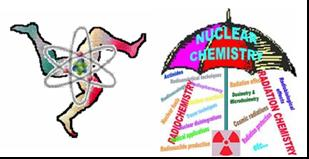Speaker
Dr
Yutaka MIYAMOTO
(JAEA (Japan Atomic Energy Agency))
Description
Abundance and isotopic ratios of trace uranium (U), thorium (Th), lead (Pb) and lanthanides in environmental samples play a key role to investigate features of the samples. The analytical data may give information on origin of the sample, dating of mineral formation, history on mineralization, and age determination of nuclear materials. Abundance and isotopic ratios of an element of interest are generally measured with high resolution inductively-coupled plasma mass spectrometers (HR ICP-MS). In most environmental samples such as rocks, soils, and airborne dusts, trace U, Th, Pb, and lanthanides are contained with major elements such as Na, K and Fe. These major elements and the polyatomic ions which originated from the co-existing elements affect accuracy of analytical results measured by ICP-MS [1, 2]. The analytes, therefore, should be separated from the interfering elements. Chemical separations are good solution for accurate analyses, but the procedures are generally complicated and time-consuming. The authors developed the technique for sequential separation of U, Th, Pb, and the lanthanides using a single anion-exchange column (resin: Muromac 1x8, particle size: 100-200 mesh, column size: 5.5 mm in diameter, 42 mm in height) and mixed media consisting of hydrochloric acid, nitric acid, acetic acid, and hydrofluoric acid [3]. With a single anion-exchange column, sequential separation of 50 ng each of U, Th, Pb, and the lanthanides in an ICP-MS calibration solution was successfully carried out. Using a mixture of acetic acid and other mineral acids (hydrochloric acid and/or nitric acid) enabled complete separation of the analytes. The absorption of the elements of interest on the column was enhanced in the mixture of acetic acid compared with simple hydrochloric acid and nitric acid media. Alkali metals, alkali earth metals, and Fe were eliminated from U, Th, Pb, and the lanthanides. The recovery yields of the elements of interest were more than 95%. This sequential separation technique was applied to an automatic system. The eluents were pressurized by compressed air, and injected into an anion-exchange column. The separation of elements of interest was optimized for several parameters including particle size, column length, and eluent flow rate. The elements of interest were completely separated within 6 hours. The peak resolution of elution curves were improved by using the pressurized separation system.
This work was supported by financial aids from the Ministry of Education, Culture, Sports, Science and Technology (MEXT) of Japan (Scientific Research (C): Grand No. 22550143).
[1] Magara, M., Sakakibara, T., Kurosawa, S., Takahashi, M., Sakurai, S., Hanzawa, Y., Esaka, F., Watanabe, K. and Usuda, S., J. Nucl. Sci. Technol. 39, 308-311 (2002).
[2] Magara, M., Sakakibara, T., Kurosawa, S., Takahashi, M., Sakurai, S., Hanzawa, Y., Esaka, F., Watanabe, K. and Usuda, S., J. Aanl. At. Spectrom. 17, 1157-1160 (2002).
[3] Miyamoto, Y., Yasuda, K., Magara, M., Kimura, T. and Usuda, S., J. Nucl. Radiochem. Sci. 10,7-12 (2009).
Author
Dr
Yutaka MIYAMOTO
(JAEA (Japan Atomic Energy Agency))
Co-authors
Dr
Kenichiro YASUDA
(JAEA (Japan Atomic Energy Agency))
Dr
Masaaki MAGARA
(JAEA (Japan Atomic Energy Agency))
Dr
Takaumi KIMURA
(JAEA (Japan Atomic Energy Agency))
